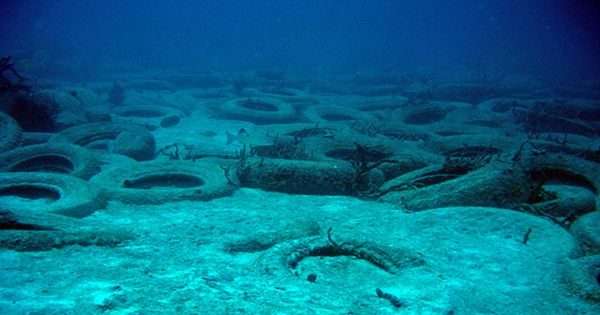You might think it is strange to throw millions of tires into the ocean in order to aid marine life, but it seemed like a good idea to people in control in the 1970s. Broward Artificial Reef Inc. (BARINC) devised a strategy in 1972 that would eventually lead to disaster: it combined the problem of disposing of automobile tires with the need to develop new fish habitats. The goal was to bury around 2 million old tires to the ocean floor, where fish would undoubtedly congregate to the “artificial reef.”
The concept sparked a surprising amount of interest. Over 100 privately owned boats, as well as the US Navy’s ship the USS Thrush, freely participated in the dumping. Goodyear Tire & Rubber Co. determined that this was the type of initiative they wanted to be a part of, so they supplied tires and equipment to bind the tires together, while additional tires were rescued from landfills. Goodyear was so excited about the idea that they hired a blimp to drop a gold-painted tire into the ocean to kick off the endeavor. The tires would “offer a home for fish and other aquatic creatures,” according to the company’s news statement, which also praised the “great characteristics of discarded tires as reef material.”
Despite its good intentions, the plan turned out to be a calamity, a total underwater car accident. Ray McAllister, a professor of maritime engineering at Florida Atlantic University who helped coordinate the project, remarked several years later, in 2007, “The really brilliant notion was to give habitat for marine species so we could double or treble marine life in the region.” “It didn’t work out that way. Now that I think about it, I see that was a horrible decision.”
Sinking fabricated materials to create reefs is not as far-fetched as it may appear. The most frequent type of artificial reef is a shipwreck, and ships have been purposefully destroyed to offer a habitat for aquatic creatures. The problem with tossing rubber into the water was its lightness, as well as the potential for tires to drift and break apart.
Only a few sponge species developed on the tires, and they did so sparingly. Worse, many of the tires were pulled free by currents. As they slid over the ocean floor, the loose tires crushed other adjacent natural corals and prevented coral reefs from forming.
In fact, as William Nuckols, the organizer of a cleanup operation described it in 2007, “they’re a continually murdering coral-destruction machine.”Since it became evident that the effort had failed, volunteers and other groups have sought to rescue the tires, but the task is enormous.
Before the Industrial Divers Corporation was hired to elevate additional tires, the US military became engaged in the cleaning and was able to remove 72,000 of them. Hundreds of thousands of people have relocated, but there are still hundreds of thousands more.
















